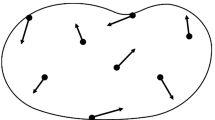Abstract
We consider the dynamics of finite systems of point masses which move along the real line. We suppose the particles interact pairwise and undergo perfectly inelastic collisions when they collide. In particular, once particles collide, they remain stuck together thereafter. Our main result is that if the interaction potential is semi convex, this sticky particle property can be quantified and is preserved upon letting the number of particles tend to infinity. This is used to show that solutions of the pressureless Euler equations exist for given initial conditions and satisfy an entropy inequality.


Similar content being viewed by others
References
Ambrosio, L., Gigli, N., Savaré, G. Gradient Flows in Metric Spaces and in the Space of Probability Measures, 2nd edn. Lectures in Mathematics ETH Zürich. Birkhäuser Verlag, Basel (2008)
Billingsley, P.: Convergence of probability measures. Wiley Series in Probability and Statistics: Probability and Statistics. John Wiley & Sons, Inc., New York, second edition, 1999. A Wiley-Interscience Publication
Brenier, Y., Gangbo, W., Savaré, G., Westdickenberg, M.: M. Sticky particle dynamics with interactions. J. Math. Pures Appl. (9), 99(5):577–617, (2013)
Brenier, Y., Grenier, E.: Sticky particles and scalar conservation laws. SIAM J. Numer. Anal. 35(6), 2317–2328 (1998)
Cavalletti, F., Sedjro, M., Westdickenberg, M.: A simple proof of global existence for the 1D pressureless gas dynamics equations. SIAM J. Math. Anal. 47(1), 66–79 (2015)
E W., Rykov Y., Sinai, Y.: Generalized variational principles, global weak solutions and behavior with random initial data for systems of conservation laws arising in adhesion particle dynamics. Comm. Math. Phys., 177(2):349–380, (1996)
Folland, G. Real analysis. Pure and Applied Mathematics (New York). John Wiley & Sons, Inc., New York, second edition, 1999. Modern techniques and their applications, A Wiley-Interscience Publication
Guo, Y., Han, L., Zhang, J.: Absence of shocks for one dimensional Euler-Poisson system. Arch. Ration. Mech. Anal. 223(3), 1057–1121 (2017)
Gurbatov, S. N., Saichev, A., Shandarin, S. F.: Large-scale structure of the universe. the zeldovich approximation and the adhesion model. Physics-Uspekh, 55(3):223, (2012)
Hale, J.: Ordinary differential equations, 2nd edn. Robert E. Krieger Publishing Co. Inc, Huntington (1980)
Huang, F., Wang, Z.: Well posedness for pressureless flow. Comm. Math. Phys. 222(1), 117–146 (2001)
Hynd, R.: A trajectory map for the pressureless euler equations. Transactions of the American Mathematical Society 373(10), 6777–6815 (2020)
Hynd, R.: Probability measures on the path space and the sticky particle system. Annali della Scuola Normale Superiore di Pisa, Classe di Scienze, XXI(Issue special):1333–1357, 2021
Hynd, R.: Lagrangian coordinates for the sticky particle system. SIAM J. Math. Anal. 51(5), 3769–3795 (2019)
Hynd, R., Kim, H. K.: Infinite horizon value functions in the Wasserstein spaces. J. Differ. Equ. 258(6), 1933–1966 (2015)
Jabin, P.-E., Rey, T.: Hydrodynamic limit of granular gases to pressureless Euler in dimension 1. Quart. Appl. Math. 75(1), 155–179 (2017)
Jin, C.: Well posedness for pressureless Euler system with a flocking dissipation in Wasserstein space. Nonlinear Anal. 128, 412–422 (2015)
Kallenberg, O.: Foundations of modern probability. Probability and its Applications (New York). Springer-Verlag, New York, second edition, 2002
Natile, L., Savaré, G.: A Wasserstein approach to the one-dimensional sticky particle system. SIAM J. Math. Anal. 41(4), 1340–1365 (2009)
Shen, C.: The Riemann problem for the pressureless Euler system with the Coulomb-like friction term. IMA J. Appl. Math. 81(1), 76–99 (2016)
Zel’dovich, Ya. B. Gravitational instability: an Approximate theory for large density perturbations. Astron. Astrophys. 5, 84–89 (1970)
Author information
Authors and Affiliations
Corresponding author
Additional information
Publisher's Note
Springer Nature remains neutral with regard to jurisdictional claims in published maps and institutional affiliations.
Partially supported by NSF grant DMS-1554130.
A Newton’s equations
A Newton’s equations
Here we show that the ODE system (1.7) has a solution on the interval \([0,\infty )\) for prescribed initial conditions. We recall the standing assumptions that \(W:\mathbb {R}\rightarrow \mathbb {R}\) is continuously differentiable, W is even, and that (1.3) holds.
Proposition A.1
Suppose \(m_1,\dots , m_N> 0\), \(x_1,\dots , x_N\in \mathbb {R}\) and \(v_1,\dots , v_N\in \mathbb {R}\). There are
satisfying
for \(t>0\) and
for \(i=1,\dots , N\).
Proof
By Peano’s existence theorem, there is a solution \(\gamma _1,\dots ,\gamma _N\in C^2([0,T))\) of the ODE (A.1) for some \(T\in (0,\infty ]\) which satisfies the initial conditions (A.2). We may assume that [0, T) is the maximal interval of existence so that this solution cannot be continued to a larger interval if \(T<\infty \). In this case, it must be that
for some \(j=1,\dots , N\). Otherwise, \(\sup _{t\in [0,T)}| {\dot{\gamma }}_i(t)|<\infty \) and
for all \(i=1,\dots , N\), and this solution \(\gamma _1,\dots ,\gamma _N\) could then be continued to \([0,T+\epsilon )\) for some \(\epsilon >0\) (Chapter 1 of [10]).
Observe
for \(t\in [0,T)\). This can be verified by differentiating the left hand side of (A.4) and by using that \(\gamma _1,\dots , \gamma _N\) solves (A.1). Arguing as we did to prove Corollary 2.9, we find
for \(t\in [0,T)\). As \(m_i>0\) for each \(i=1,\dots , N\), (A.3) could not hold for any \(j=1,\dots , N\). We conclude that \(T=\infty \). \(\square \)
Rights and permissions
About this article
Cite this article
Hynd, R. Sticky particles and the pressureless Euler equations in one spatial dimension. Math. Z. 301, 2155–2183 (2022). https://doi.org/10.1007/s00209-022-02991-z
Received:
Accepted:
Published:
Issue Date:
DOI: https://doi.org/10.1007/s00209-022-02991-z




